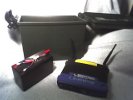|
Greetings. First time poster, though I was part of a group that tried to get HSMM-MESH off the ground here in the Tulsa area back in 2011/2012, without success... now it looks like it might take off thanks to the enthusiasm of a different group. So I've had quite a bit of experience with the Linksys hardware over the years, flashing both with OpenWRT and DD-WRT, and other things. Set up a demo mesh back in the 2011/12 timeframe with the WRT54Gs and it worked quite well -- as long as you were close enough. We are terrain- and tree-challenged here, though, so it was tough getting links working at our homes. Now that I'm coming back to it, I'm thrilled to see support for Ubiquiti hardware -- especially 900MHz hardware. 900MHz would have been the answer to our problems a few years ago, I think, even with its narrower bandwidth. 900MHz isn't used much here, but we'll certainly respect the request to keep the bandwidth at 5MHz. Among some of the other things that we can do with BBHN, one of the things that has been discussed in our group is using it for public service event communication support. With 2.4GHz equipment, that's nearly impossible -- however, with 900MHz, it becomes very possible. 900MHz could also be used for medium-to-long haul links between non-portable nodes when necessary (and it will be here IMO). One of the issues I see for portable nodes, however, is DTD switching or bridging the Ubiquiti devices. I know Linksys can be 'hacked' to support DTD (though I'd prefer not to use Linksys in the field) but I'd like to know what folks are doing to enable DTD for Ubiquiti hardware with BBHN without any external hardware (e.g. switches, routers, Pi, whatever). From what I've gathered from reading about the Nanobridge, it would *appear* that device will indeed handle bridging without the need for additional hardware -- and while I like that, I do not like the idea of a fixed dish on a portable node -- rather have something removable and easy to assemble/disassemble for field portable use). It doesn't appear that the Rocket M9 or the Nanostation Loco M9 will actually bridge -- though I may be wrong about that. So, I guess, the tl;dr version of this is -- can I bridge an M2 device (e.g. BulletM2) to an M9 device (any) without an external piece of equipment -- and, if so, which M9 device will work? Thanks, Tony KA5TRO |
